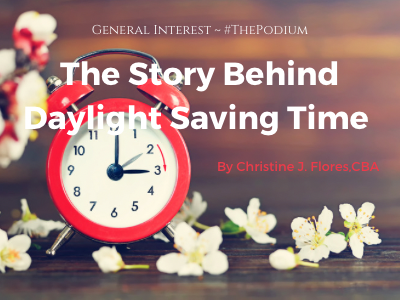
Christine J. Flores, CBA
Most people have noticed that the days are getting a little bit longer these days. There’s pretty decent daylight until about 6:00 p.m. or so. If you’re like me, you’re counting down the days until we “Spring Forward” into Daylight Saving Time. While many of you miss that extra hour of sleep, I can only think of more fun at the end of the day! I simply cannot wait to turn the clock ahead!
In the United States, daylight saving time lasts for 34 weeks – from early to mid-March to the beginning of November. Not all states observe daylight saving time – Arizona and Hawaii do not observe it, as well as some U.S. territories.
Attempts at gaining more sunlight began with Ancient Civilizations as they adjusted their daily schedules to the sun, often dividing daylight into 12 hours, so that each daylight hour became longer during spring and shorter during autumn. The Romans kept time with water clocks that had different scales for different months of the year. For example, in Rome, the third hour from the sunrise started at 9:02 solar time and lasted 44 minutes at the winter solstice, but at the summer solstice it started at 6:58 and lasted 75 minutes. From the 14th century onward, equal-length hours replaced the unequal hours. In 1810, the Spanish National Assembly of Cortes of Cadiz moved certain meeting times forward by one hour from May 1 through September 30, but did not change the clocks. Private businesses also voluntarily changed their operating hours to suit daylight conditions. There were others who proposed daylight savings time. In 1895 New Zealand entomologist George Hudson proposed daylight saving time as a way to gain after-hours daylight to pursue his hobby of collecting insects. Prominent English builder and outdoorsman William Willett proposed daylight saving time in 1905 when he noticed how many Londoners slept through a large part of the day. He also appreciated the additional daylight hours to pursue his passion of golf. In 1908 daylight saving time was enacted in Ontario, Canada.
Germany and its World War I ally Austria-Hungary adopted daylight saving time on May 1, 1916, during World War I, in an effort to conserve fuel. The rest of Europe followed soon after. But we didn’t adopt daylight saving time in the US until March 19, 1918. It was unpopular, and was abolished after World War I. On February 9, 1942, Franklin Roosevelt instituted a year-round daylight saving time, which he called “war time.” This lasted until September 30, 1945.
It was not until the passage of the Uniform Time Act of 1966 that standard time across the country was mandated. Under this Act, the clocks would advance one hour at 2:00 a.m. on the last Sunday in April, and turn back one hour at 2:00 a.m. on the last Sunday in October. States had the option to exempt themselves from daylight saving time. From January 1974 through April 1975, in an effort to conserve energy due to the 1973 oil embargo, Congress enacted a trial period of year-round daylight saving time.
Under the Sunshine Protection Act, unanimously passed last year by the Senate, the seasonal changing of clocks would be eliminated. However, the bill has stalled in the House, where it remained in a committee until the expiration of the previous Congress. This legislation, introduced by Senator Marco Rubio (Florida), suggested it would reduce crime, encourage kids to play outside and lower the risk of heart attacks and automobile accidents. However, there are contradicting studies which found that the risk of heart attacks went up after the clocks were turned forward. There is also a study by the American Academy of Sleep Medicine which supports a permanent switch to standard time, as our bodies function best with more sunlight in the morning. It is also thought that what we know as standard time more closely matches our body’s natural internal clock. More light in the morning makes it easier to wake up for the day, and easier to fall asleep in the evening.
There are some countries that have implemented a switch to daylight saving time all year long. Argentina, Belarus, Iceland, Morocco are a few that do not change their clocks in the Autumn.
Senator Rubio has reintroduced the legislation that would make Daylight Saving Time permanent in the United States. There are many who support this idea; though there may be more who would prefer to make Standard Time the permanent time schedule. The one thing that everyone agrees on is that they’re tired of changing back and forth. It will remain to be seen if we will see one time schedule in the United States any time soon.
For more information on the subject, a search of the internet will lead you to some interesting articles, including those found at the links below.
https://en.wikipedia.org/wiki/Daylight_saving_time
https://www.nbcbayarea.com/news/local/spring-forward-daylight-saving-time/3172810/
Categorized in: General
| << previous | next >> |








